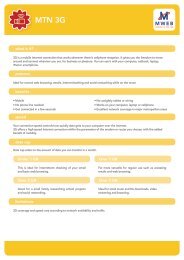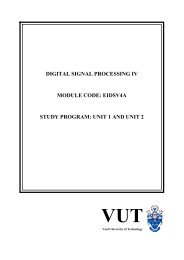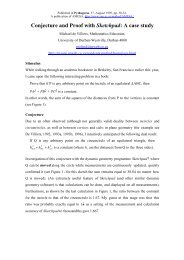process instrumentation i module code: eipin1b study ... - Home Mweb
process instrumentation i module code: eipin1b study ... - Home Mweb
process instrumentation i module code: eipin1b study ... - Home Mweb
You also want an ePaper? Increase the reach of your titles
YUMPU automatically turns print PDFs into web optimized ePapers that Google loves.
EIPINI Chapter 5: Temperature Measurement Page 5-18<br />
Type Positive Isolation Negative Isolation Outer Temperature<br />
element colour element colour isolation range (°C)<br />
K Chromel Yellow Alumel Red Yellow -200 to 1200<br />
E Chromel Purple Constantan Red Purple -200 to 800<br />
J Iron White Constantan Red Black -200 to 750<br />
T Copper Blue Constantan Red Blue -200 to 350<br />
S<br />
90% Platinum<br />
10% Rhodium<br />
Black Platinum Red Green 0 to 1500<br />
Table 5-2<br />
Types K, E, J and T, are the 'general purpose' thermocouples. Type K is the most<br />
popular thermocouple in use today while type T is used for lower temperature<br />
applications. The conventional type J thermocouple, even with its unfavourable iron<br />
lead, is still popular, mainly because of its widespread use in older instruments. Type<br />
E is the most sensitive of the standard thermocouples (68μV/°C). Noble metal type S,<br />
has low sensitivity(10μV/°C), is expensive and used in the higher temperature range.<br />
Thermocouple alloys referred to in Table 5-2, are chromel (chrome and nickel), alumel<br />
(aluminium and nickel) and constantan (copper and nickel).<br />
Different colour <strong>code</strong>s have been adopted for thermocouple wire and product<br />
identification and the colour <strong>code</strong>s listed in Table 5-2, are used in the United States.<br />
5.10.4 Thermocouple construction<br />
Thermocouple thermometers are available in different shapes and in different<br />
coverings. Three basic types of construction can be recognised:<br />
Wire construction<br />
The most basic construction of the thermocouple<br />
is the two dissimilar metals joined (welded)<br />
together to form the measuring junction. In this<br />
form, the exposed junction offers good response<br />
times, but may suffer from environmental<br />
damage. A bare thermocouple element is shown<br />
in Figure 5-16.<br />
Sheathed construction<br />
To improve mechanical strength, mineral<br />
insulated thermocouples were developed. The<br />
thermocouple wires are embedded in compressed<br />
mineral oxide powder and enclosed in a metal<br />
sheath, usually stainless steel or inconel (nickelchromium-iron<br />
alloy). A completely insulated<br />
thermocouple is shown in Figure 5-17 (a).<br />
Bare thermocouple junction<br />
Magnesium<br />
oxide<br />
Figure 5-16<br />
Insulated junction<br />
Thermocouple<br />
wires<br />
Figure 5-17 (a)<br />
Inconel<br />
sheath

















